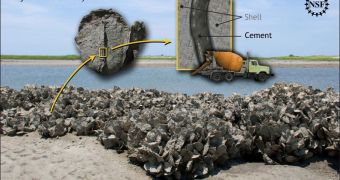Oysters differ from other marine animals that produce glue to affix themselves to each other via the fact that they produce cement to keep their colonies together.
The conclusion, which belongs to a new study by experts at the Purdue University and the University of South Carolina (USC), may holds great importance for experts seeking to develop conservation programs.
Some of the primary roles oysters fulfill include safeguarding coastlines against erosion and storm damage, as well as filtering water, and providing a safe haven for other marine organisms.
At this point however, oyster reefs are not too common in the world. As people started developing a taste for the creatures, demand caused harvesting to go into over-drive.
In some places, stocks decreased by as much as 98 percent in the past two centuries alone. The trend is unlikely to be curbed anytime soon, experts say.
The new conclusion are the result of a project that seeks to better understand how oyster reefs form, and how they interact with each other. The work has relevance for reintroduction projects.
What the collaboration recently discovered is that the organisms produce a rather unique adhesive material called cement, which differs widely from the glue-like adhesive other marine creatures use.
“Such knowledge can help us develop biomedical materials including wet setting surgical adhesives. These insights may also help us prevent marine bioadhesion for keeping ship hulls clean, thereby reducing drag, fuel consumption, and carbon emissions,” says Jonathan Wilker.
The expert, who holds an appointment as a chemist at Purdue, was one of the lead researcher in the new investigation.
“We wanted to learn how oysters attach themselves to surfaces, and each other, when building reef structures,” he adds, quoted by the US National Science Foundation (NSF).
Wilker and colleagues presented their discoveries today, August 24, at the 2010 Annual Meeting of the American Chemical Society (ACS). The convention takes place in Boston, Massachusetts.
A print version of the research will be published in the upcoming, September 15 issue of the esteemed Journal of the American Chemical Society.
“Our results indicate that there is a chemically distinct adhesive material holding the oysters together. The cement contains significantly more protein than the shell. We also observed both iron and highly oxidized, cross-linked proteins, which may play a role in curing the material,” Wilker concludes.

 14 DAY TRIAL //
14 DAY TRIAL //